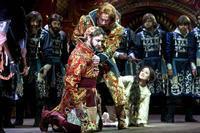SUBMIT UPDATES
Among the seven marriages Russian Tsar Ivan IV most short-lived and strange was third with Martha Sobakinoj. The sad fate of this young beauties are very briefly described in historical literature. She became a heroine of the Opera of Nikolai Rimsky-Korsakov (1844-1908) "the Tsar's bride"; However, the libretto of this beautiful piece of music is very far from the true events of the second half of the 16th century. However, the past becomes less interesting, and the story of Martha Sobakinoj, third wife of Tsar Ivan continues to attract attention for many centuries later. The Opera is based on the drama of the Russian poet, translator and playwright L. Mey, written in the year 1849. The essay "the Tsar's bride" was started by composer N.a.Rimsky-Korsakov in February 1898, and completed in 10 months. Premiered October 22 (November 3) 1899 in Moscow theatre of Savva Mamontov private opera. The first view, according to the Chronicles of "statements" Moscow, asked the national musical celebration. The Orchestra was a pupil of the composer M.m. ippolitov-Ivanov, sketches of scenery wrote M.a.vrubel, while his wife, a prominent singer Of Zabela-Vrubel created the image of Martha is one of the most beautiful in Russian opera.
1890 's-this is the era of high maturity in the creative life of N. A. Rimsky-Korsakov. One opera is written in the draft or design in sketches, another instrumentuetsâ, the third is staged. at the same time in different theaters of resumes before the works. Rimsky-Korsakov's Opera of this period varied in forms and genres. By definition, the composer himself, "Mlada", "the night before Christmas" and "Sadko" form a trilogy; then comes the mention again the words of the author, "once again the doctrine or alteration." It is about "a melody, melodiousness», which is reflected in his romances and Chamber operas of this period (" Mozart and Salieri ", the final version of the prologue to" Pskovitânke ") and especially in the Tsar's bride".
Appeal to the drama by Lev Mey was "long-standing" by the composer's intention is probably still with the 1860 's, when the Rimsky-Korsakov composed another play by Mey his "Pskovitânku," and the story "the Tsar's bride" thought of Balakirev and Alexander Borodin (the latter has made even a few sketches of choirs-Guardsmen, whose music was later used in "Prince Igor"). The brilliant Opera playwright, brilliant connoisseur of theatrical circumstances, Rimsky-Korsakov himself planned the scenario of the new Opera, and "finalizing the libretto with razrabotkoû lyrical moments and plug in, extra scenes" instructed Ilya Tûmenevu, theatrical, political figure and his former student. (By the way, writing a few years later "Serviliû" based on the play by Mey, Rimsky-Korsakov "swept" all the drama of this, so beloved to him the author.)
Its one of the few operas Nikolay Andreevich treated with such tenderness, as "the Tsar's bride". Perhaps this was due to the fact that the composer drew the story itself. The era of the reign of Ivan the terrible has always been a big interest. Images of doomed to ruin a beautiful and chaste Martha, passionate and deeply unhappy Ljubiša, at least the hapless in their unrequited love for Martha Boyar Dirty could not waken Rimsky-Korsakov's creative imagination.
Biography of Tsar Ivan IV, nicknamed the terrible, very rich in events and very unusual. During his long life the Tsar had not one or two but seven wives. One of them was Marfa Sobakina.
Marriage is great sovereigns of Moscow was solemn and colorful ceremony, preceded by a great preparation. With the rise of Muscovy in the late 14th century in Russia, a new tradition of the King's wedding. However, the Byzantine symbol, rulers of Russia adopted the Byzantine tradition of the bride's selection of the best girls State. For the first time, "the choice of the bride" was arranged by his father, Vasily III, Ivan the terrible: the Decree from Moscow all military people had to bring their daughters to the parade. Selection criterion was not only beauty, but also the health of girls. Selected candidates were waiting for new shows until the Tsar will not make their final choice. As soon as the girl was chosen and narekalas? of the Royal bride, her life has changed radically. From now on, the girl became very special: the bride, the wife of the Tsar and was viewed as a holy person. Now she had to be hidden from human eyes: look at gosudarynû not allowed virtually anyone. Relatives could no longer call it its relative-wedding ceremony, which followed soon after the King's choice of a bride, made for them, as for all Russians, a simple girl in the Grand Queen of ...
In the year 1572 in Aleksandrovskaya Sloboda was conducted review of the best girls State. Tsar Ivan the terrible had to elect a bride: "Missing widowhood, although not chaste, it has long been looking for a third wife of ... Of all the
Cast and Creative team for The Tsar’s Bride at Ekaterinburg State Academic Opera and Ballet Theatre
Music Director: Pavel Klinichev (The Bolshoi Theatre of Russia)
Staging: Mikhail Pandzhavidze (The Bolshoi Theatre of Russia)
Sets and costumes designed by Fyodor Fedorovsky, People’s Artist of the USSR, and Nonna Fedorovskaya for the 1966 Bolshoi Theatre production
Renewal Designer: Igor Oganov
Light Designor: Sergey Shevchenko (The Bolshoi Theatre of Russia)
Chorus Master: Valery Kopanev, Merited Arts Worker
Staging: Mikhail Pandzhavidze (The Bolshoi Theatre of Russia)
Sets and costumes designed by Fyodor Fedorovsky, People’s Artist of the USSR, and Nonna Fedorovskaya for the 1966 Bolshoi Theatre production
Renewal Designer: Igor Oganov
Light Designor: Sergey Shevchenko (The Bolshoi Theatre of Russia)
Chorus Master: Valery Kopanev, Merited Arts Worker



